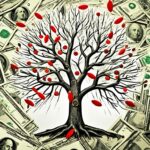As you navigate the complex landscape of investing, understanding the impact of dividend cuts is essential to maintaining a resilient portfolio. When companies announce dividend policy changes, it’s not just a minor footnote in the financial news—it can send ripples across the stock market dynamics, shaking up investor confidence and potentially leading to significant investment strategy adjustments. It’s like a seismic event that tests the structures built by investors; those with a deeper understanding and stronger strategies often withstand the tremors.
For you as an investor, a dividend cut might mean more than a simple reduction in regular income; it’s a signal to reassess the financial well-being of the company in question. Such moves can influence your decision to hold, sell, or buy more shares depending on your read of the situation. It’s situations like these where your insight into the subtleties of the stock market becomes invaluable, allowing you to adapt and thrive even when the currents shift.
Key Takeaways
- Dividend cuts typically indicate that a corporation is experiencing financial hardships or strategic shifts, often leading to a decline in stock price.
- A reduction in dividends directly affects your expected stream of investment income and could prompt portfolio reassessment.
- The stock market may react negatively to dividend cuts, as they can be interpreted as a lack of confidence in a company’s future growth.
- A proactive approach is necessary to adjust investment strategies in the face of dividend cuts.
- For those invested in companies undergoing dividend policy changes, staying informed on market trends and company updates is crucial.
The Nature of Dividends and Their Market Impact
Unveiling the essence of dividends reveals their critical role in both rewarding shareholders and signaling corporate vitality. Understanding this financial instrument’s intrinsic value and its subsequent influence on market behaviors enables you to make informed decisions regarding your investment portfolio.
Role of Dividends in Shareholder Value
When a company distributes profits as dividends, it not only returns value to its shareholders but also sends a potent message about its financial health and the sustainability of its profitability. Dividends typically arise from retained earnings, evidencing a company’s surplus after covering operational, investment, and financial expenses—a robust position that can bolster shareholder loyalty and allure prospective investors.
Stock Price Adjustments Post-Dividend Declaration
Following the dividend declaration, a company’s stock may experience notable price fluctuations. The anticipation of receiving dividends often prompts investors to assign a higher value to the stock, reflecting an increase in demand. Conversely, a predictable adjustment occurs after a stock reaches its ex-dividend date; the price customarily drops by an amount equivalent to the dividend issued. This change mirrors the modified expectations of incoming cash flows, integrating the impact of dividend reduction into the ongoing stock value analysis.
A detailed look into these phenomena presents a clear picture of how dividends, while seen as separate benefits, are inextricably linked to stock valuations and subsequent shareholder returns. It’s imperative to factor in these mechanics of the market when planning investment strategies or conducting equity research, especially given the dividend-declaration impact on the stock’s observable market value.
Understanding the Psychology Behind Dividend Cuts
The distribution of dividends has traditionally been a pillar of trust between a company and its investors, providing not just a steady income stream but also serving as a financial signal of the company’s health. A cut in these dividends, while often viewed through a purely financial lens, also operates within the realm of dividend psychology. This area of investor sentiment concerns itself with the nuances of how investors react emotionally and logically to changes in a company’s dividend policy, which in turn affects market perception and behavior.
Investor Perceptions of Financial Stability
For many investors, regular and consistent dividends epitomize financial stability. Companies with a strong record of dividend payouts are often regarded as financially robust, fostering a positive sentiment that can buoy its stock price. Indeed, dividend psychology suggests that these regular rewards reinforce investors’ perceptions of a company’s enduring profitability and its care for shareholder returns.
However, when dividends are cut, investors might interpret the reduction as a distress signal, a potential indicator of lurking troubles within the company. Whether these concerns are valid or not, the financial signaling inherent in reducing dividends can be potent enough to sway investment decisions and shape market narratives.
Market Reaction to Changes in Dividend Policies
The market’s reaction to dividend cuts often reflects collective investor sentiment, which can take a negative turn when such announcements are made. The reduction or elimination of dividends is sometimes perceived as a company struggling to maintain its financial footing, possibly navigating choppy operational or economic seas. Even if the reality is otherwise—say, the dividend cut is made to reallocate capital for growth—the initial reaction might still be one of concern, leading to stock sell-offs and a lessened appeal in the market’s eyes.
A common fallout of diminished investor confidence is the potential decrease in a company’s stock price, making it critical for investors to keenly observe how companies manage and communicate their dividend policies.
The following table captures how investor sentiment might change with respect to dividend policies:
| Dividend Policy Change | Investor Sentiment | Market Perception |
|---|---|---|
| Stable or Increasing Dividends | Positive, Trusting | Strong, Reliable Company |
| Decreased Dividends | Wary, Concerned | Potential Financial Instability |
| Dividend Suspension | Negative, Distressed | High Financial Risk, Avoidance |
In conclusion, navigating the waters of dividend cuts requires a keen understanding of dividend psychology and how it intertwines with the mechanics of market perception. As an investor, being attuned to these undercurrents is as vital as analyzing the hard financial data that drives investment decisions.
Typical Market Behavior Following Dividend Reductions
When you hear news of a company dividend slashing, it’s not just an isolated financial event—it’s a precursor to a series of reactions within the stock market. The immediate stock price reaction to dividend cuts almost inevitably leans towards the negative side. Investors, doing a double-take at their investment income impact, might be quick to adjust their portfolios, leading to a frosty market behavior towards the affected stocks.
Anticipate a potential dip in investment income that could prompt you to reassess the stability and long-term returns of your holdings. Companies with a track record of maintaining or growing dividends are typically favored, which can intensify selling pressure on stocks experiencing dividend reductions. This selling pressure not only reflects in dwindling stock prices but can also impart a more broad-stroke effect on the market, influencing investment patterns and sector confidence.
For a tangible understanding, consider the following table, which illustrates hypothetical investor reactions to dividend cuts:
| Action | Immediate Reaction | Market Behavior |
|---|---|---|
| Company Announces Dividend Cut | Investor Sentiment Dips | Selling Pressure Increases |
| Stock Price Begins to Drop | Income-focused Investors Exit | Market Absorbs Selling, Adjusts Prices |
| Market Stabilization Post Reaction | Value Investors May Enter | Slow Recovery or Further Decline |
The implications of these market behaviors are multifaceted, so your approach should be proactive and well-informed. You’ll want to watch closely as the market reflects the collective sentiment and responds accordingly. Whether your strategy leans towards divestment or seizing the opportunity for value investment, staying attuned to these nuances will empower you to make decisions that align with your investment goals.
Keep in mind that while dividend cuts often stir up immediate apprehension, they don’t always signify a company’s inevitable decline. Some businesses cut dividends strategically to reallocate funds towards growth or capital-intensive projects. In such scenarios, while the short-term market behavior might skew towards the negative, the long-term view could be brighter if the company’s strategic maneuvers pay off.
How Corporate Financial Strategy Affects Dividend Payouts
Every investor knows that dividends are the sweet fruit of a well-maintained portfolio. The role they play in strategic financial management is vital, as they directly impact your investment returns. However, an essential aspect of maximizing those returns involves understanding how corporate decisions lead to dividend payout cuts and the effects of such actions on your investments.
Let’s delve into the principles that guide companies in this complex financial sphere, examining how the imperative balance between corporate earnings and shareholder returns is a key driver in optimizing long-term investment health and wealth.
Strategic Investments and Impact on Dividends
The decisions a company makes about its capital are a clear reflection of its priorities and outlook. Strategic investments, such as pursuing acquisitions or funding innovative projects, necessitate considerable financial resources. To fuel these endeavors, a company might opt to reduce its dividend payments as a way to reallocate profits internally.
This rebalancing act can often lead to an unfortunate side effect for shareholders — dividend payout cuts. Yet, such strategic decisions can potentially lead to higher investment returns in the future if these investments pay off. Understanding a company’s growth strategy is crucial; it offers insights into possible future earnings and, by extension, the sustainability of its dividends.
Company Profitability and Dividend Sustainability
An undeniable truth in the corporate world is that a company must be profitable to sustain dividend payouts. When earnings are robust, dividends can flow generously. However, if a company starts to experience a dip in corporate earnings, this can spell trouble for dividend consistency.
Companies faced with such challenges may enact dividend payout cuts as a means of preserving capital. While trimming dividends can be a disappointment to investors, it is often a necessary maneuver within strategic financial management to maintain the company’s overall financial stability and ability to invest in long-term growth opportunities.
Here’s how changes in corporate profitability can impact dividend sustainability:
| Earned Revenue | Profit Margins | Dividend Sustainability |
|---|---|---|
| Increasing | Stable or Growing | Likely Sustainable |
| Decreasing | Shrinking | At Risk |
| Variable | Fluctuating | Uncertain Sustainability |
In summary, comprehending the delicate interplay between strategic financial management decisions and their implications for dividends will empower you to anticipate and react to dividend payout cuts. Keeping a pulse on these aspects will aid you in sculpting a portfolio that not only weathers the ups and downs of corporate earnings but also secures a steady stream of investment returns.
The Impact of Dividend Payout Cuts
When you’re invested in dividend-paying stocks, dividend payment cuts can be a troubling sign, not only impacting your stream of passive income but also potentially heralding a decline in stock valuation. These cuts often offer a peek into the underlying financial health of a company, serving as financial health indicators that savvy investors monitor closely. The effects of dividend cuts extend beyond immediate investor income effects; they may signal a stock value decrease that necessitates a thoughtful reassessment of the investment’s place in your portfolio.
If a company you’re invested in slices its dividend, it’s natural to wonder about the state of its balance sheet. Could rising debts or shrinking earnings be the culprit? Or maybe the company is reallocating its financial resources to fund strategic moves like acquisitions or stock buybacks. Regardless of the rationale, the news can shake investor confidence, as consistent and predictable dividends are often seen as a hallmark of a financially stable enterprise.
To navigate these choppy financial waters, you should scrutinize not only the dividend cut itself but also the broader context: is the dividend payment cut a response to transient challenges, or does it point to deeper, structural issues within the company? This understanding will inform whether to stay the course or seek safer harbors for your investment capital.
Let’s map out the changes to an investor’s income following a hypothetical reduction in dividends and the correlation with stock value:
| Dividend Percentage Cut | Projected Income Loss | Potential Stock Value Impact |
|---|---|---|
| 10% | Moderate Decrease in Expected Income | Minor Value Adjustment |
| 25% | Significant Decrease in Expected Income | Moderate Value Adjustment |
| 50% or More | Major Decrease in Expected Income | Substantial Value Adjustment |
Each row in this table reflects a scaling effect: smaller dividend cuts might spur minor adjustments, while larger cuts can lead to substantial investor actions and downward pressure on a stock’s market price. You’re right to use this information as a barometer for the company’s financial stability and future prospects. By doing so, you remain proactive in safeguarding your interests and ensuring your portfolio continues to work in service of your financial objectives.
In the end, while dividend payment cuts can be disconcerting, they also serve as a valuable alert system. Paying attention to these signals ensures you won’t be caught off guard, allowing you to maintain control over the health and performance of your investment portfolio.
Dividend Yields and Their Attractiveness to Investors
In the world of investing, the allure of dividends can hardly be overstated. Dividend yields are considered a linchpin in dividend investment return, serving as a gauge for the income an investor can expect relative to the price they pay for the stock. An investor versed in financial ratio analysis often turns to dividend yields when assessing the passive income potential of their stock portfolio. But yields alone are not enough. The payout ratio complements this by offering a lens through which the reliability and sustainability of those dividend payments can be viewed. Let’s take a closer look at what these terms mean and how you can calculate them.
Calculating Dividend Yield
The dividend yield calculation is straightforward yet powerful. To calculate the yield, you divide the annual dividends per share by the stock’s price per share. For instance, if a company pays out annual dividends of $2 per share and the stock is currently priced at $40 per share, the dividend yield is 5% ($2 / $40). The dividend yield is a dynamic metric, sensitive to changes in the dividend payout and stock price, making regular reassessment important for investors.
The Payout Ratio as an Indicator of Dividend Reliability
A fundamental piece in financial ratio analysis is the payout ratio, which computes the proportion of earnings a company pays out in the form of dividends. Essentially, it is the piece of the profit pie that goes directly into shareholders’ pockets. A balanced payout ratio is often seen as a sign of company maturity, indicating a disciplined approach to sharing profits while retaining enough capital to invest in growth and operational stability. In the pursuit of dividend investment return, investors should look for companies with a rational balance in their payout ratio over time, as it can hint at the sustainability of a company’s dividend payments.

The following is a simplified representation of how to approach the dividend yield and payout ratio:
| Annual Dividends Per Share | Stock Price Per Share | Dividend Yield (%) | Payout Ratio (%) |
|---|---|---|---|
| $2 | $40 | 5 | 50 |
| $3 | $60 | 5 | 75 |
| $1 | $20 | 5 | 25 |
In this example, you see companies with the same dividend yield percentage, yet the payout ratios can vary considerably. A higher payout ratio might suggest less room for future growth or even a potential cut in dividends if earnings drop, whereas a lower one may indicate ample space for future investment and dividend growth.
Arming yourself with the knowledge of how to calculate and interpret these financial ratios will give you an edge in selecting stocks that not only provide attractive yields but also suggest a reliability— a combination that, in the long haul, can contribute robustly to your overall investment returns.
Case Studies: Dividend Suspension and Shareholder Effects
As you consider the landscape of your investments, particularly those tied to dividend yields, it’s crucial to unpack the repercussions of a dividend suspension through real-world examples. These shareholder impact case studies provide a window into the immediate and rippling effects that such dividend policy changes have on individual portfolios and the broader market.
Take, for instance, the outbreak of the COVID-19 pandemic. A crisis that upended usual business operations and instigated a wave of dividend suspensions across countless sectors. Major players in the banking sector, like Wells Fargo, and other blue-chip companies were quick to slash or completely halt dividend disbursements. This decision, more a necessity than a choice, was the response to the burgeoning need to conserve capital amid global economic uncertainty.
How did this impact you, the shareholder? Initially, there was an unmistakable decline in the passive income stream, a consequence acutely felt by income-dependent investors. The long-term effects, however, extended beyond personal portfolios. As dividends were cut, a corresponding dip in stock prices was often observed, a direct market adjustment to the news that future cash flows would be leaner.
The table below illustrates a simplified comparison between pre-pandemic dividend yields and the market aftermath following the dividend cuts initiated due to COVID-19:
| Company | Pre-Pandemic Dividend Yield | Post-Cut Dividend Yield | Stock Price Adjustment (%) |
|---|---|---|---|
| Major Bank | 3% | 1.5% | -3% |
| Blue-Chip Corporation | 4% | Suspended | -6% |
| Energy Sector Giant | 5% | 2% | -4% |
These figures showcase the initial knock-on effect of reduced yields on the stock prices. But the numbers only scratch the surface; the overall sentiment and future investor behavior also shifted, leading to strategic portfolio reevaluations and, in some cases, a broad withdrawal from previously favored sectors.
Investing during times of drastic dividend policy changes is not for the faint of heart. Yet, these historical snapshots are essential for recognizing patterns and preparing for similar market adjustments in the future. They teach that flexibility, informed decision-making, and a well-calibrated response to news of dividend suspension are key to safeguarding your investment strategy against unexpected financial currents.
Strategies for Investors Facing Dividend Slashing
If you’re an investor who’s recently faced a dividend cut, you’re likely seeking strategies to stabilize your income and protect the value of your investment portfolio. Given the unpredictability of market conditions, applying dividend-cut strategies is a wise move to buffer against the effects of such financial changes. There are several approaches you can take to ensure portfolio resilience during these times.
One such method for maintaining stability within your investments is investment risk diversification. By spreading your assets across various sectors and differing dividend histories, you’re less likely to feel the full impact of a dividend reduction across your entire portfolio. Similarly, constructing a reinvestment plan can also pave the way for long-term growth, countering the short-term losses from dividend cuts.
Diversification to Manage Income Risk
Investment diversification is more than a tactic; it’s a prudent step to manage income risk in your portfolio. It involves balancing your investments across various industries and asset classes. This approach can safeguard against the risk of dividend cuts, as not all sectors will likely react synonymously to economic pressures. Here’s how diversification can help manage potential income fluctuations and safeguard your investments:
- Reduces the reliance on any single revenue stream, diminishing the effect of cuts.
- Spreads out risk, preventing significant losses if one sector underperforms.
- Offers exposure to different economic cycles, some of which may counterbalance others.
Effective diversification implies selecting investments not only by their sector but also by the stability of their dividends. Consider adding stocks from utilities or consumer staples, which traditionally have a low correlation with economic downturns and tend to maintain dividends.
Reinvesting Dividends for Long-Term Growth
Incorporating a dividend reinvestment plan (DRIP) is a forward-looking strategy that can catalyze the growth of your investments over time. Reinvesting dividends allows you to purchase more shares, incrementally increasing your ownership in the company. This compounding effect can contribute significantly to long-term growth and portfolio resilience, especially during periods of market volatility.
- Automatically reinvest dividends to purchase additional shares, taking advantage of compounding growth.
- A DRIP strategy boosts your share count, cushioning the impact of future dividend reductions.
- Over time, reinvested dividends can account for a substantial portion of portfolio growth.
Remember that reinvesting dividends into companies with strong fundamentals and stable dividend histories is crucial. This steady approach can gradually build your portfolio, making it robust enough to withstand dividend-cut strategies if and when they occur.
| Investment Type | Diversification Benefit | Reinvestment Growth Potential |
|---|---|---|
| Utilities | Stability during volatility | Steady dividend reinvestment |
| Consumer Staples | Consistent performance in downturns | Reliable dividends for reinvestment |
| Technology | Growth during market rallies | Higher potential for capital gains |
| Healthcare | Demographic resilience | Long-term growth from reinvesting |
Strategies like these are not just protective measures—they’re proactive steps towards solidifying your financial footing in the market, ensuring that you’re well-positioned to sustain and grow your investments, regardless of dividend fluctuations.
Dividend Cuts: Immediate and Long-Term Consequences
When a dividend cut announcement echoes through the stock market, it’s not just the sound of shrinking paychecks for shareholders. These are warning bells, signaling immediate financial consequences and potentially ushering in a cascade of long-term investment effects. For you, the shareholder, understanding these ramifications is not only about witnessing a dip in your cash flow; it’s about being ready to adapt your income strategy swiftly.

The ink has barely dried on the press release, and you may already see the decrease in your investment’s value—a stark reminder of the vulnerability investments face when companies rearrange their priorities. You might question the future of such stocks in your portfolio: will they rebound, or are they setting a precedent for continued financial strife?
Over time, dividend cut ramifications can reshape the investment landscape. A once stable income-generating asset might become a question mark, compelling you to consider realignment of your assets. Here’s where the narrative splits for every investor: you either seek alternatives to offset the potential instability or stay in place, hoping for a positive shift in the company’s direction.
As you grapple with these shifts, consider the broader implications for your portfolio. Will this inspire income strategy adaptation, pushing you towards a mix of growth and dividend stocks or fixed income securities to maintain predictable returns?
| Dividend Cut Impact | Immediate Actions | Potential Long-Term Strategies |
|---|---|---|
| Reduced Investor Cash Flow | Review budget and income expectations | Asset reallocation to stabilize income |
| Stock Value Declines | Portfolio assessment for risk exposure | Exploration of growth-driven investments |
| Subsequent Investor Confidence Erosion | Monitor company reports and market analysis | Strategic diversification to mitigate similar future risks |
Dividend cuts can be a forewarning, hinting at deeper issues within the company. Scrutinizing the cause of the cut is as crucial as the action itself. Is it a red flag for poor financial health or a strategic move for capital reallocation? Your diagnostic of these scenarios will determine the resilience of your investment portfolio amidst long-term investment effects.
Regardless of the why and the when, the ability to remain nimble, making deft adjustments to your investment approach, can mark the difference between compounding losses and capitalizing on new opportunities. In the complex symphony of the stock market, a dividend cut might just be a change in tempo—an opening for a different investment composition that still plays in tune with your financial goals.
Assessing Company Health After Dividend Payment Cuts
When a company reduces or eliminates its dividend payments, it’s a pivotal moment that warrants a diligent financial health assessment. As an investor, your ability to discern the reasons behind the dividend cut and the company’s future prospects can significantly influence your decision-making process. Earnings analysis, understanding the dividend track record, and making future dividends projection are all essential facets of evaluating a company’s financial resilience in the wake of such changes.
Analyzing Financial Reports and Earnings Calls
Scrutinizing a company’s financial statements and earnings calls provides a treasure trove of information. Aspects such as cash flow statements, balance sheets, and income statements offer concrete data that paint a picture of the company’s current financial landscape. Earnings calls can yield insights into management’s perspective on performance, challenges, and strategies, which are invaluable for a comprehensive earnings analysis.
By delving into these resources, you can identify patterns that may not be immediately obvious—such as whether a dividend cut is a red flag or a strategic reallocation of resources. For instance, if the cut is accompanied by increased capital expenditure in growth areas, it might indicate potential for future expansion. On the other hand, if debt levels are rising while earnings are stagnating, it might suggest financial strain.
Dividend History and Future Outlook Projections
The dividend track record is like a company’s financial fingerprint, revealing the company’s commitment to shareholder returns. A history of steady or increasing dividends is often synonymous with financial stability. Conversely, dividend cuts or erratic payouts could hint at underlying issues or a shift in corporate priorities that may not align with maximized shareholder returns.
Looking forward, future dividends projection demands an evaluation of the company’s earnings outlook, investment opportunities, and cash flow forecasts. This projection can guide investors on whether the company expects to restore, maintain, or further cut dividends, offering a glimpse into its trajectory and whether its financial course aligns with your investment strategy.
As part of your financial health assessment, consider comparing the following elements:
| Financial Aspect | Current Assessment | Future Projections |
|---|---|---|
| Cash Flow | Review for stability and growth potential | Forecast based on operational efficiency and market opportunities |
| Dividend Track Record | Analyze past consistency and growth | Estimate potential for restoration based on profitability |
| Debt Levels | Evaluate against assets and earnings | Assess management’s plan to manage or reduce debt |
| Profitability | Examine margins and compare to industry benchmarks | Project future earnings and potential dividend increases |
By integrating these analyses, you position yourself to make knowledgeable inferences about the company’s ability to navigate through a dividend cut, potentially emerge stronger, and provide future returns in alignment with your investment goals.
International Perspective on Dividend Policy Changes
As a global investor, your investment portfolio is exposed to a multidimensional financial canvas. The fluctuations in global dividend policies often reflect a broader narrative of international market trends and economic forces. Diverse economic conditions across different regions and the strategic adaptation of corporations in response to these conditions can greatly influence cross-border investment impact. Analyzing these trends provides a critical understanding required for optimizing your international investment approach and mitigating risks.
When dividends become a borderless conversation, the savvy investor recognizes the signals different markets express in their divergent dividend ballets – a dance choreographed by economic vigor, political stability, and corporate confidence.
For instance, a region experiencing economic growth may witness companies showing bolstered confidence in their dividend strategies, with more generous payouts reflecting strong sectoral performance. This uptick can make the region’s stocks more attractive, drawing your attention to potentially lucrative cross-border investment opportunities underpinned by sound economic conditions influence.
Where currency risks loom large, dividends paid in local currencies subject to volatility may affect the real return on your investment. Developing a robust currency risk mitigation strategy is essential when including foreign dividend-paying stocks in your portfolio. Geopolitical tensions can also sway dividend policies unpredictably, calling for a keen eye on international news and policy shifts.
Regulatory environments play a crucial role too. Nations with favorable taxation policies on dividends could sweeten the deal for international investors. However, staying ahead of changes in tax legislation requires vigilance; unexpected tax hikes or the introduction of new fees can erode your dividend returns.
To illustrate the variances in global dividends, consider the following table, which shows how different countries can present distinct opportunities and risks:
| Country | Dividend Yield Trend | Regulatory Environment | Economic Condition Influence |
|---|---|---|---|
| United States | Stable Growth | Investor-friendly, low double-taxation | Dependent on Federal Reserve policies |
| Germany | Volatile with Industry Shifts | Strict, High Taxation on Dividends | Sensitive to EU economic stability |
| Brazil | High Yields | Incentive-driven, tax exemption for certain investors | Strong correlation with commodity prices |
| Japan | Modest Increments | Complex, varying tax rates | Impact of Abenomics and monetary policy |
Understanding the landscape of global dividend policies demands more than just recognizing the high yields. It’s about weaving into your investment tapestry the threads of international market trends, the ever-present cross-border investment impact, and how economic conditions influence the fabric of global dividends. By treating each international opportunity as a unique investment case, you bolster your capacity for discerning investment choices that benefit from a world of dividends, unhindered by geographical confines.
Alternative Income Streams Amidst Dividend Suspension
When traditional dividends start to falter, it’s time to gaze beyond the horizon of conventional stocks and consider alternative income sources that ensure stability and growth. Bonds, REITs investing, and high-yield opportunities are some of the allies you can turn to. These vehicles provide the dual benefits of generating income and diversifying your portfolio, which is particularly crucial during lean times when dividends are suspended or reduced.

Bonds, REITs, and High Yield Investments as Substitutes
The world of bonds offers a refuge for investors yearning for reliable income. With a spectrum ranging from government-backed treasuries to corporate bonds, this sector presents various risk levels aligned with corresponding returns. In the realm of strategic investment planning, it’s prudent to consider the creditworthiness of bond issuers and the duration of your bond investments to optimize your income stream.
REITs, or Real Estate Investment Trusts, boast a reputation for distributing considerable dividends derived from real estate income. REITs can deliver both stable cash flows and long-term capital appreciation, making them an excellent addition to any income-focused investment portfolio. They are especially attractive when traditional real estate investment is out of reach for individual investors due to high capital requirements.
High-yield opportunities often come dressed as high-dividend stocks, ETFs, or mutual funds, promising significant income but also carrying a greater risk. These high-yield opportunities must be approached with due diligence and an eye for the intricate balance between risk and reward.
| Investment Type | Income Potential | Risk Level |
|---|---|---|
| Government Bonds | Lower Yield, Stable | Low |
| Corporate Bonds | Varied Yield, Moderate to High | Medium to High |
| REITs | Higher Yield, Regular | Medium |
| High-Dividend Stocks | High Yield, Variable | High |
Creative Investment Strategies During Lean Times
Lean times call for creative strategies, and savvy investors might consider delving into industries historically resistant to economic downturns. Sectors such as healthcare, utilities, and consumer goods often demonstrate resilience, continuing to generate revenue even during challenging economic climates.
Systematic investment plans (SIPs) bring a disciplined approach to wealth building, allowing you to invest a fixed amount regularly, thereby averaging out the cost of investment over time. SIPs are a strategic option during market downturns, as they offer the chance to purchase more shares when prices are low, potentially yielding higher returns as the market recovers.
Ultimately, strategic investment planning amid dividend suspensions is not about hastily finding a stand-in for lost income. It’s about recalibrating your portfolio with a mix of alternative income sources that can tide you over the short-term challenges and bolster your financial foundation for the future.
Conclusion
As you find yourself navigating dividend cuts, the landscape of your investment goals need not be mired in uncertainty. Instead, staying ahead of the curve with investment portfolio adaptation strategies allows you to turn market fluctuations into stepping stones for financial growth. Recognizing the intricacies behind dividend reductions is critical; it’s the knowledge that transforms reactive measures into proactive investor responses.
Embracing market trend insights fortifies your ability to foresee potential shifts within your investment sphere. Whether it’s a company’s diminishing returns or a sector’s overall downturn, your diligence in monitoring these changes empowers you to make tactical moves that safeguard your financial interests. It reinforces the importance of being multidimensional in your approach – poised to explore alternative income streams when traditional dividends are not promising.
Ultimately, maintain a dynamic outlook to ensure that each investment aligns with your broader financial blueprint. While the market may ebb and flow with regulatory changes, economic shifts, and unexpected global events, your capacity to adeptly manage and evolve your investment strategy is what will define your success. Strive to embody the very resilience and adaptability you seek for your portfolio, and let these attributes become the compass that guides you toward your long-term financial objectives.
FAQ
How do dividend cuts impact investors and the stock market?
Dividend cuts usually signal financial strain or a shift in company strategy, often resulting in a decreased stock price and affecting investor income. These changes can prompt a reassessment of investment strategies and might be viewed as negative indicators of a company’s future growth potential.
What is the role of dividends in shareholder value?
Dividends are often seen as a reward for investors and a sign of corporate health and profitability, enhancing shareholder value. They signal to investors that the company is able to return a portion of its earnings back to shareholders, which is typically associated with financial stability and may influence positive investor sentiment.
How does the stock price adjust after a dividend declaration?
Post-dividend declaration, the stock price often increases as investors are willing to pay a premium for the stock to receive the upcoming dividend. However, after the stock goes ex-dividend, the price usually drops by approximately the amount of the dividend, reflecting the payout adjustment.
What are investor perceptions of financial stability related to dividend cuts?
Dividend cuts can lead investors to perceive a company as financially unstable, causing concern that the reduction in dividends may indicate broader internal issues that could have negative future ramifications for the company and its investors.
How does the market react to changes in dividend policies?
The market typically reacts negatively to dividend cuts due to the perceived signal of financial distress or strategic uncertainty. This can result in a sell-off of the company’s stock, leading to a decline in the stock price and reduced market attractiveness.
What is typical market behavior following dividend reductions?
The typical market behavior following dividend reductions includes a fall in the stock price, as the reduction suggests a weaker financial position for the company. Investors seeking steady income may pull out of the stock, further driving down its price.
How does corporate financial strategy affect dividend payouts?
Corporate financial strategy can lead to alterations in dividends if profits are redirected towards internal investments or acquisitions. Companies may lower dividends to conserve capital for strategic growth opportunities or because earnings are insufficient to cover previously established payouts.
What is the impact of dividend payout cuts on investors?
Dividend payout cuts can reduce investors’ passive income and signify potential financial troubles within a company, often resulting in a decline in stock value and a need for investors to reassess the place of the affected stock within their portfolio.
How do you calculate dividend yield, and what does it indicate to investors?
The dividend yield is calculated by dividing the annual dividends per share by the stock’s price per share. It’s a financial ratio that indicates how much a company pays out in dividends in relation to its stock price, and it is crucial for investors who are assessing the potential for income from their investments.
What is the payout ratio and why is it important?
The payout ratio calculates the proportion of earnings a company pays out as dividends and serves as an indicator of the sustainability of these payments. A consistent payout ratio suggests a balance between dividend payments and investment back into the company, which is vital for its long-term financial health.
How did dividend suspensions during the COVID-19 pandemic affect shareholders?
The wave of dividend suspensions during the COVID-19 pandemic had a profound effect on shareholders, as many companies in financial distress chose to cut dividends in order to conserve capital. This resulted in decreased yields for shareholders and often led to a decline in stock prices, reflecting the negative impact on investor returns.
What diversification strategies can investors use to manage income risk from dividend slashing?
To manage income risk, investors can diversify their investments across different sectors and stocks with various dividend histories. Not all companies usually cut dividends at the same time, so diversification can help mitigate the impact of dividend cuts from a single or a few companies.
How can reinvesting dividends contribute to long-term growth?
Reinvesting dividends into stable companies can contribute to the compounding growth of an investor’s portfolio, helping to offset the impact of dividend cuts from other investments. This approach can foster portfolio resilience and long-term wealth building, even amidst market volatility.
What are the immediate and long-term consequences of dividend cuts?
In the short term, dividend cuts can result in reduced cash flow for investors and a decrease in portfolio value. Long term, these cuts may indicate underlying issues in a company that could affect its future viability and the returns to shareholders, prompting the need for strategic adjustments to investment approaches.
How can investors assess a company’s health after dividend payment cuts?
To assess a company’s health after dividend cuts, investors should analyze financial reports and earnings calls for indicators of cash flow, debt levels, and profitability. Reviewing a company’s dividend history and management’s future outlook can provide insights into the likelihood of dividend restoration or further reductions.
How do dividend policy changes impact international investors?
Dividend policy changes can affect international investors by creating fluctuations in dividend stability and yields due to differing economic conditions, sector shifts, and corporate strategies globally. International investors must navigate additional challenges such as currency risk and geopolitical factors.
What alternative income streams can investors consider amidst dividend suspension?
During times of dividend suspension, investors may look towards bonds, real estate investment trusts (REITs), and other high-yield investments as alternative sources of income. These options can provide diversified income streams, reducing reliance on dividends from equities.
What creative investment strategies can be employed during financially lean times?
During lean times, investors might consider targeting industries less impacted by economic downturns or employing systematic investment plans that leverage market downturns to buy stocks at lower prices. Such strategies can build resilience and potential for growth when market conditions improve.












